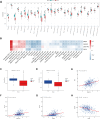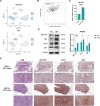Hepatitis B virus X protein (HBx)-mediated immune modulation and prognostic model development in hepatocellular carcinoma
- PMID: 40577282
- PMCID: PMC12204523
- DOI: 10.1371/journal.pone.0325363
Hepatitis B virus X protein (HBx)-mediated immune modulation and prognostic model development in hepatocellular carcinoma
Abstract
Hepatitis B virus (HBV) X protein (HBx) is critical in hepatocellular carcinoma (HCC) development, but its influence on tumor immunity and the tumor microenvironment (TME) remains unclear. This study aimed to construct a prognostic model based on HBx-related genes and explore their relationship with immune infiltration and immunotherapy response. Through transcriptome sequencing of our HBx-expressing HepG2 cells and analysis of HCC patient data from the cancer genome atlas (TCGA) and genotype-tissue expression (GTEx), we identified seven HBx-related genes, nuclear VCP-like (NVL), WD repeat domain 75 (WDR75), NOP58 nucleolar protein (NOP58), Brix domain-containing protein 1 (BRIX1), deoxynucleotidyltransferase terminal interacting protein 2 (DNTTIP2), MKI67 FHA domain interacting nucleolar phosphoprotein (NIFK), and ribosome production factor 2 (RPF2), associated with poor prognosis. LASSO Cox regression narrowed these to four key genes (BRIX1, RPF2, DNTTIP2, and WDR75), which were used to develop a prognostic riskscore signature. High-risk patients exhibited lower survival rates, decreased infiltration of anti-tumor immune cells, poorer responses to immunotherapy, and increased immune evasion. Among the four genes, DNTTIP2 showed higher expression in single-cell data, was linked to migration inhibitory factor (MIF) signaling, and may play a pivotal role in shaping an immunosuppressive TME. Elevated DNTTIP2 expression was confirmed in HBx-expressing HepG2 cells and HBV-infected HCC samples. This study highlights a novel HBx-related four-gene prognostic model that predicts clinical outcomes, immune infiltration, and immunotherapy response, offering insights into HCC progression and potential therapeutic targets.
Copyright: © 2025 Zhong et al. This is an open access article distributed under the terms of the Creative Commons Attribution License, which permits unrestricted use, distribution, and reproduction in any medium, provided the original author and source are credited.
Conflict of interest statement
The authors have declared that no competing interests exist.
Figures








Similar articles
-
Identification of anoikis-related subtypes and a risk score prognosis model, the association with TME landscapes and therapeutic responses in hepatocellular carcinoma.Front Immunol. 2025 Jun 17;16:1602831. doi: 10.3389/fimmu.2025.1602831. eCollection 2025. Front Immunol. 2025. PMID: 40599775 Free PMC article.
-
The impact of de novo lipogenesis on predicting survival and clinical therapy: an exploration based on a multigene prognostic model in hepatocellular carcinoma.J Transl Med. 2025 Jun 18;23(1):679. doi: 10.1186/s12967-025-06704-y. J Transl Med. 2025. PMID: 40533802 Free PMC article.
-
A Novel RNA Methylation-Related Prognostic Signature and its Tumor Microenvironment Characterization in Hepatocellular Carcinoma.Technol Cancer Res Treat. 2024 Jan-Dec;23:15330338241276895. doi: 10.1177/15330338241276895. Technol Cancer Res Treat. 2024. PMID: 39155614 Free PMC article.
-
The Epigenetic Modulation of Cancer and Immune Pathways in Hepatitis B Virus-Associated Hepatocellular Carcinoma: The Influence of HBx and miRNA Dysregulation.Front Immunol. 2021 Apr 29;12:661204. doi: 10.3389/fimmu.2021.661204. eCollection 2021. Front Immunol. 2021. PMID: 33995383 Free PMC article. Review.
-
Deciphering adenosine signaling in hepatocellular carcinoma: Pathways, prognostic models, and therapeutic implications.Clin Mol Hepatol. 2025 Jul;31(3):706-729. doi: 10.3350/cmh.2024.1068. Epub 2025 Feb 5. Clin Mol Hepatol. 2025. PMID: 39905839 Free PMC article. Review.
References
MeSH terms
Substances
LinkOut - more resources
Full Text Sources
Medical
Research Materials
Miscellaneous

